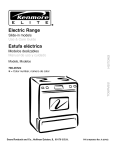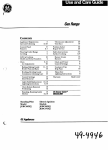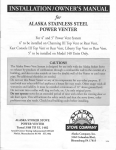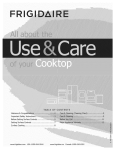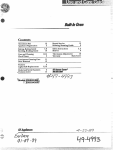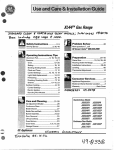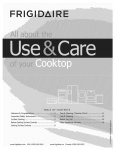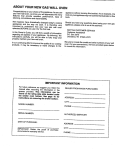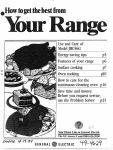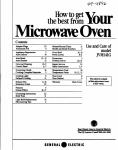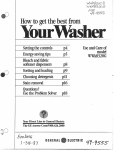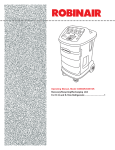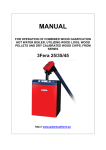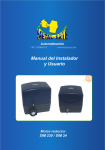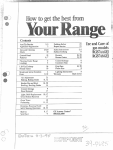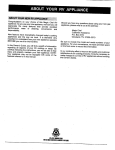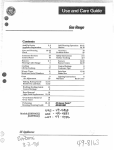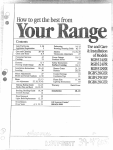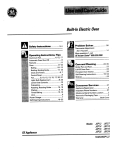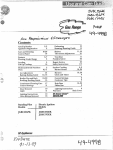Download GE JGKC15 H User's Manual
Transcript
I UseandCareof gasmodels Features Usingtheoven Specialcareof continuous-cleaning oven Questions? UsetheProblemSolver p4 p6 pll p15 . . YourDirect LimetoG(7< ($+’C :~ &~L’ ‘-- , TheGEAmwverG-W-I-77 L/’T : L-2-,,2--/’ “.- . . . . ; . ,“ &@ =&*. S+dy Insmlctims . .........2-3 Featuresof!bur CNen . ........4 AutomaticC&en-mm, C2Gckml. MinuteT’hm2r.. ...5 using Jbw chum , . . . ., ... , ..,6 Baking . . . . . “. . . . . . . ........7 Baking‘chart . . . . +. . ........8 R(mthlg, c%art . . . . . . ........9 Eln-ding,CYM3rt . . . . . . . . . . . . =. m special Gu%d Cmthmws-(%aring Oven. . . H ~M=emdcleaning , , . . . . . . . II-13 CleaningChart . . . . . . . . . . .. ..14 ProblemSolver.. . . . . . . . . .. ..15 It is intendedto helpyouoperate andmaintainyournewoven properly. Keepit handyforanswersto your questions. ● Iflbu NeedService. . . .......15 “V&irrmty . . . . . . . . . . .13ackCover TiiJmOF%all range CCmtr’ck Nycm smell gas: 1.open 2. touch +dectrical switches’ 3. anyopen fhm? call your 4. gas *non$tWm electricswitches on or CMbecause sparks may ignite the gas. FOR Keep the area dew’ and free mm-%1 and (mK?r and If youdon’tunderstandsomething or needmorehelp.write(include yourphonenumber): ConsumerAffairs GeneralElectricCompany AppliancePark Louisville,KY40225 down the modd and serialnumbers. You’llfindthemon a labellocated insidetheovenon theleft side.See page4. Thesenumbersare alsoon the ConsumerProductOwnership RegistrationCard thatcamewith youroven. the pit 13cfbresendinginthiscard. pleasewritethesenumbershere: Model Number Serial Number Use thesenumbersin any correspondenceor service callsconcerningyouroven. H you received a damagedCW2n... Immediatelycontactthe dealer(or builder)thatsoldyouthe oven. Sawtime Beforeyourequest service;. . Checkthe ProblemSolveron page 15.It listsminorcausesof operatingproblemsthatyoucan correctyourself. this all e -9 get your mm have showyouthe of the ovengas cut-off valveand howto shut it offif necessary. and ~Haveyour wen bya installer,in accordancewiththe InstallationInstructions.Any adjustmentandserviceshouldbe performedonlybyqualifiedgas rangeinstallersor service technicians. ~Plugyour ovenintoa 120-vW wtkt only.Do not removetheroundgroundingprong fromthepkg. Ifi aoubtaboutthe groundingofthehomeelectrical system,it is yourpersonal 2 responsibilityandobligationto haveanungrounded outletreplaced witha properly-grounded threeprongoutletin accordancewith theNationalElectricalCode.Do notuseanextensioncordwith thisappliance. @Besure all packing are removedhm the ovenbefore operatingit, topreventfireor smokedamageshouldthepacking materialignite. @~~ ~~~~your own is correctly adjustedby a service or for the typeofgas or ill) on =—w= .%+ @ ~hid it k to be be convertedfromonetypeto the other.Seekstdlation Instructions. ~$d. &is (%n “- (continued) e~ ~DWt leavechiklrenaloneor unattendedwherean ovenis hotor in operation. Theycould beseriouslyburned. ~Donftallo~t’anyoneto climb, standor hang on the door or broihwcompartment. They coulddamagetheovenandeven [ipitovercausing severepersonal injury. QCAUTION: DO NOT STORE ITEMSOF INTERESTTO CHILDRENIN CABINETS ABOVEANOVEN-CHILDREN CLIMBINGONTHEOVENTO REACHITEMSCOULDBE SERIOUSLY INJURED. ~Neverwear loosefittingor hanginggarments whileusing the appliance.Flammable materialcouldbeimited if roughtin contactwithflameor hotovensurfacesandmaycause severeburns. ~Neveruse your appliancefor warmingor heatingthe room. Prolongeduseoftheovenwithout adequateventilationcanbe hazardous. ~Donot use wateron grease fires.Neverpickup a flaming pan.Turnoffburner,thensmother flamingpanbycoveringpan completelywithwellfittinglid, cookiesheetor flattray.Flaming greaseoutsidea pancanbeput outbycoveringwithbakingsoda or,if available,a multi-pu~ose drychemicalor foam. u not s~o~fl~~na~~e matefi~ in an oven. ~Donot let cookinggreaseor otherflammablematerials accumulatein or near theoven. @Donot useovenfor a storage area. @Standawayfromthe oven whenopeningovendoor.The hot air or steamwhichescapes can causeburns to hands,face and/or eyes. @Keepovenfree fromgrease buildup. @Placeovenshelvesin desired positionwhileovenis cool. ~Pullingout shelfto the shelf stop is a conveniencein lifting heavyfinds.It isalsoa precaution againstburns from touching hot surfacesofthe dooror oven walls. @Don’tuse aluminumfoil anywherein the ovenexceptas describedin this book.Misuse couldresultin a firehazardor damagetotherange. ~Don’theat unopenedfood containersin the oven.Pressure couldbuildup and the container couldburst causingan injury. @Useonlyglasscookwarethat is recommendedforuseingas oven. ~Whenusing cookingor roastingbagsin oven,follow themanufacturer’s directions. ~Whencookingpork?follow ourdirectionsexactlyandalways cookthemeatto at least170°F, Thisassuresthat,in theremote possibilitythattrichinamaybe presentin themeat,it willbe killedandmeatwillbe safeto eat. 3 @Ahvaysremovebroiler pan frombroiler compartmentas soonas youfinishbroiling. Greaseleftinthepancancatch fireifovenis usedwithout removingthegreasefromthe broilerpan. ~Whenbroiling9if meat is too cioseto the flame,the fat may ignite.Trimexcessfattoprevent excessiveflare-ups. @Makesure broiler pan is in placecorrectlytoreducethe ‘. --possibilityofgreasefires. — @If youshouldfiavea grease fire in the broiler pan, turnoff oven,andkeepdrawerclosedto containfireuntilit burnsout. @Cleanonlyparts listedin this Useand Care Book. @Keepovencleanand free of accumulationsofgreaseor spilloverswhichmayignite. If YouNeed Service 6 he ProblemSolver>5 eReacl6T on page 15ofthisbook. @Don’tattempt to repair or replaceany part of your oven unlessit is specifically recommendedin this book. All otherservicingshouldbe referred toa qualifiedtechnician. SAVE !s!% -i%sa%c:. . @ I -\ — Models JGKM5GEH (Standard Oven) JGKC15GEH(Continuous-CleaningOven) ModelJGKC16GEH(Continuom+CleaningOven) See page JGKS15GEH JGKC15GEHI JGKC16GEHI e 5 I I FeatureIndex 1 MinuteTimer 2 AutomaticOvenTimer 3 DigitalElectricClock ~ 4 RadialElectricClock I 5 ovenblhts~itch I 6 Oven SetKnob I 7 OvenTemPKnob 1 8 OvenInteriorLight 9 Oven Shelves 10 Oven ShelfSupports 11 RemovableOvenBottom 12 RemovableOvenDoor I 13 RemovableBroilerCompartmentDoor I 14 BroilerPanand Rack 15 ModelandSerial Numbers 16 Continuous-CleaningOvenInterior 1 17 BroilerCom~artrnent I I I I I 6 o e e I e e 5 I e 6 6 I e I e 6 6 12 12 12 10, 13 2 11 10.13 4 I 5 5 5 I I I I 1 e —— e e @ , I I e e I e I I e I I I e 7%6clock JGK!315GEH& JGKC15GEH TheMinuteTimerhas been combinedwiththe ovenclock.Use it to timeall yourprecisecooking operations.You’llrecognizeit as thepointerwhichis differentin colorthanthe clockhands. Minutesare markedup to 60 on the centerring ofthe clock. JGKS15GEH &JGKC15GEH TosettheClock,pushtheknobin andturn the clockhandsto the rightto the correcttime.Thenlet the knobout andcontinueturning to OFF. 2. Setthe STARTcontrol.Pushin andturn the STARTknobto the timeyouwanttheovento turn itself on. (If youwantitto startcooking immediately,do notset the Start time.) 3. Setthe Sl_OPcontrol.Pushin andturn the STOPknobto thetime youwantthe ovento turn itselfoff. Note:There mustbeat leasta half hourdifferencebetweenthe START andSTOPdialsforthe automatic controlto work. To set the Minute Timer, turnthe knobto the left, withoutpushingin, untilthepointerreachesthenumber f minutesyouwantto time. Model JGKC16GEH To set the CIock, pushinthe center ModelJGKC16GEH ~lleMinuteTimeris the largedial to the leftof thedigitalclock.Use it to timeall yourprecisecooking operations.Thisdial also changes thedigitalclock. To set the Minute Timer, turn thecenterknobclockwise,without pushingin, untilthepointerreaches thenumberof minutesyouwantto time(upto 60). At the end of the time set on , ither Minute Minder. a buzzer unds to tell you time is up. Turn knobofthe MinuteTimerandturn the knobin eitherdirectionto set the digitalclocknumeralsto the correcttime. (Aftersettingthe clock,let the knobout andturn the MinuteTimerpointerto OFF.) AutomaticOwenTimer ThisTimerwillautomaticallystart and stopyourovenfor you.Here’s whatyoudo: L Makesurebothyourovenclock andtheSTARTdialshowthecorrect timeof day.Whenthe STARTknob ispushedinandturned,itwill“pop” intoplacewhenthe time shownon the ovenclockis reached. thekmob,withoutpushing in, until thepointerreachesOFF andthe buzzerstops. 5 4. Setthe OVENSETknobto AUTOOVEN. 5. Setthe OVENTEMP knobto the desiredcookingtemperature. Nowthe ovenwillturn itselfon immediatelyor at a later Starttime thatyouset, cookat thetemperature youselectedand turn itselfoffat the Stoptime youselected. Aftertakingfoodoutof the oven, be sureto turn theOVENTEMP controlto off andthe OVENSET knobto the MAN. OVENsetting whereit shouldbe keptfor normal ovenuse. The OWII and broiler burners on )“ouroven are lighted by electric ignitioneliminating the need for scmdingpilotlightswithconwmtly burningflame. C,4LJTION: DO N~ MAKEANY ATTEMPT’ TOOPERATETHE ELECTRICIGNITIONOVEN DURINGAN ELECTRICAL POWERFAILURE.Resumption ofelectricalpowerwhenOVEN TEMPcontrolis in anyposition otherthanOFF wiHresultin automaticignitionof the oven burnerand couldcausesevere burnsif, at thetime, youwere attemptingto lightthe burnerwith a match. lb Lightthe Oven Burner Turnthe OVENTEMP knobto the desiredtemperature.The burner shouldignitewithin60 seconds. M Adjustment An air adjustmentshutterforthe ovenburnerregulatesthe flowofair to theflame. Removethe broilerpan and rack, pullthebroilercompartmentdrawer outto the “stop”positionor remove thebroilercompartmentshelfand you’llfind the shutteragainstthe backwallof thecompartment. screwand rotatethe shut~erto allow moreor lessair intotheburnertube as needed. When the right amountofair flowsintotheburner,the flame shouldbe steady,withapproximately l-inchblueconesand shouldnot extendoutoverthebaffleedges. oval shelves &%O~~ UsingYourOwn 1. Lookat thecontrol.Besureyou understandhowto set it properly. 2. Checkthe insideof theoven. Lookat the shelves.Practice removingand replacingthem whiletheovenis cool. 3. Readthe informationandtips on the followingpages. 4. Keepthis bookhandywhereyou canreferto it—especiallyduring the first fewweeksof getting acquaintedwithyouroven. (hen ‘lkmperatureControl TheOVENTEMPc&trol is locatedon the upperovencontrol panel. The shelvesare designedwith stop-locksso whenplacedcorrectly on_theshelfsupports,theywillst~p beforecomingcompletelyout of the ovenand willnottilt whenyou are removingfoodor placingfood on them. Whenplacingcookwareon a shelf, pullthe shelfoutto the “stop” position.Placethecookwareon the shelf, then slidethe shelfback intothe oven.Thiswilleliminate reachingintothehotoven. Toremovethe shelvesfromthe ove for cleaning,pulloutto stop position,lift upon front and pull themout. ShelfPositions The ovenhas fourshelfsupports— A (bottom),B, C and D (top).Shelf positionsfor cookingare suggested on Bakingand Roastingpages. Ove~ Light Use switchon controlpanelto turn lighton and off. Simplyturn the knobto the desired cookingtemperatures,whichare markedin 25°F.incrementson the dial. It will normallytake30 to 60 secondsbeforethe flamecomeson. Afterthe ovenreachesthe selected temperature,the ovenburnercycles offcompletely,thenon witha full flameto keepthe oventemperature controlled. ‘h adjust the f’low.ofair to the burner,loosenthe Phillipshead 6 Eikm’tosetMm”Range h“ 1. Positionthe shelfor shelvesin theoven. 2. Close oven door,turn OVEN I“EMPknobto desiredtemperature andpreheatovenfor about 10 minutesif preheatingis necessary. 3. Place foodin ovenon centerof shelf.Allowat leastan inchbetween edgeof bakewareand ovenwallor adjacentutensils. If cooking on two shelvesat the sametime, placeshelvesabout4 inchesapart and staggerfoodon them. 4. Checkfoodfordonenessat minimumtimeonrecipe.Cook longerif necessary.Switchoff heatandremovefood. reheating is important when using temperaturesbelow225”F.and whenbakingfoodssuch as biscuits, cookies,cakesandother pastries. Preheatingis notnecessarywhen roastingor for long-timecooking ofwholemeals. Mostbakingis doneon the second shelfposition(B)from the bottom. Whenbakingthreeor four items, ,l~c~Wushelvespositionedon the secondand fourthsetsof supports (B& D) from bottomof oven. Bakeangelfoodcakeson firstshelf position(A) frombottomof oven. Baking Tips @Followa testedrecipeand measurethe ingredientscarefully. If youare usinga packagemix, followlabeldirections. ~If moistureis noticeableon the frontof theovenor on theoven windowwhenfirstturningon the oven,leavetheovendoorajarfor a fewminutesor untiltheovenis warm. CAKES Cake rises higher on one side @Batterspreadunevenlyin pan. e Do notopentheovendoorduring a bakingoperation—heatwill be lostandthebakingtimemightneed to be extended.Thiscouldcause poorbakingresults. Cakes cracking on top ~ Checkoventemperature. ~Do notdisturbtheheatcirculation in theovenwiththeuseofaluminum foil. If foilis used,placea small sheetof it, about10by 12inchesat the most, on a lowershelfseveral inchesbelowthefood.Do not placefoilon the ovenbottom. CommonBaking Problems and PossibleSolutions Pm Burning around edges ~ Oventoofill; avoidovercrowding. @Edgesof crusttoothin. @Incorrectbakingtemperature. Bottom crust soggy and unbaked @Allowcrustand/orfillingto cool sufficientlybeforefillingpie shell. ~Fillingmaybe toothinorjuicy. ~Fillingallowedto standin pie shellbeforebaking.(Fillpie shells andbakeimmediately.) ~Ingredientsandpropermeasuring affectthe qualityof thecrust. Use a testedrecipeand goodtechnique. Makesurethereare no tinyholes or tearsin a bottomcrust.“Patching” a pie crustcouldcausesoaking. Pie filling runs over ~ Topandbottomcrustnotwell sealedtogether. @Edgesof pie crustnotbuiltup highenough. @Toomuchfilling. ~ Checksizeof pieplate. Pastry is tough; crust not flaky @TOOmuchhandling. @Fattoo softor cut in toofine. Rolldoughlightlyandhandleas littleas possible.” 7 @Ovenshelvesnotlevel. @Usingwarpedpans. @Incorrectpan size. ~Battertoothick,followrecipe or exactpackagedirections. ~Checkfor propershelfposition. ~Checkpansizecalledfor in wipe. ~Impropermixingof cake. Cake falls ~ Toomuchshortening,sugaror liquid. e Checkleaveningagent,baking powderor bakingsodato assure freshness.Makea habitto note expirationdatesofpackaged ingredients. e Cakenotbakedlongenoughor at correcttemperature. ~If addingoil to a cakemix, make certainthe oil is thetypeand amountspecified. Crust is hard e Checktemperature. g Checkshelfposition. Cake has soggy layer or streaks at bottom UIUnderminingingredients. g Shorteningtoo softfor proper creaming. g Toomuchliquid. Cooms & Imxmm Doughy center; heavy crust on surface ~ Checktemperature. @Checkshelfposition. e Followbakinginstructions carefi.dlyas givenin reliablerecipe or on conveniencefoodpackage. ~ Flat cookiesheetswill givemore evenbakingresults.Don’tovercrowd foodson a bakingsheet. 8 Conveniencefoodsusedbeyond their expirationdate. Browning more noticeable on one side ~ Ovendoor notclosedproperly, checkgasketsea!. g Checkshelfposition. L Aluminumpansconductheatquickly.For most conventionalbaking,light,shinyfinishesgivebestresults becausetheyhelppreventover-browningin the timeit takesfor heatto cookthe centerareas.Werecommend dull(satin-finish)bottomsurfacesofpans for cakepans - and pie plates to be sure thoseareasbrowncompletely. 2. D.trkor non-shinyfinishes,alsoglassand pyroceram, gcwrallyabsorbheatwhichmayresultin dry, crisp crusts.Reduceovenheat25°F.if lightercrustsare desired.Preheatcast ironfor bakingsomefoodsfor rapid browningwhenfoodis added. Shelf Positions Oven Temperatures Time, Minutes Shiny Cookie Sheet B, C 400°-4750 15.20 B, A 350°-4000 20-30 B B 400°-4500 350° 20-40 45-55 Preheat cast iron pan for crisp crust. Muffins Popovers Shiny Metal Pan with satin-finish bottom Cast Iron or Glass Pan Shiny Metal Pan with satin-finish bottom Shiny Metal Muffin Pans Deep Glass or Cast Iron Cups A, B B 400°-4250 375° ~()-3(3 45-60 Quick loaf bread Yeastbread (2 loaves) Plain rolls Sweet rolls Metal or Glass Loaf Pans Metal or Glass Loaf Pans Shiny Oblong or Muffin Pans Shiny Oblong or Muffin Pans B A, B A, B B, A 350°-3750 375°-4250 375°-4250 350°-3750 45-60 45-60 10-25 20-30 Decrease about 5 minutes for muffin mix. Or bake at 450”F.for 25 minutes, then at 350”F.for 10to 15minutes. Dark metal or glass gives deepest browning. For thin rolls, Shelf B maybe used. For thin rolls, Shelf B maybe used. Cakes (without shortening) Angel food Jelly roll Sponge Aluminum “llbe Pan Metal Jelly Roll Pan Metal or Ceramic Pan A B A 325°-3750 375°-4000 325°-3500 30-55 10-15 45-60 Metal or Ceramic Pan Shiny Metal Muffin Pans Metal or Glass Loaf or Tube Pan Shiny Metal Pan with satin-finish bottom Shiny Metal Pan with satin-finish bottom Metal or Glass Loaf Pans A, B B A, B 325°-3500 350°-3750 275°-3000 45-65 20-25 2-4 hrs. B 350°-3750 20-35 B 350°-3750 25-30 B 350° 40-60 %ownies 3rop Metal or Glass Pans Cookie Sheet B, C B, C 325°-3500 350°-4000 25-35 10-20 refrigerator lolled or sliced Cookie Sheet Cookie Sheet B, C B, C 400”-425° 375°-4000 6-12 7-12 A, B, C B 350°-4000 300°-3500 30-60 30-60 B 325° Food Bread Cookware Biscuits (Win. thick) Coffeecake Corn bread or muffins Gingerbread Comments Canned, refrigeratedbiscuits take 2 to 4 minutes less time. Two piece pan is convenient. Line pan with waxed paper. Cakes Bundt cakes Cupcakes Fruit cakes Layer Layer, chocolate Loaf Paper liners produce more moist crusts. Use 300”F.and Shelf B for small or individual cakes. cookies Bar cookies from mix use same time. Use Shelf C and increase temperature 25 to 50”F.for more browning. Fruits, OtherDesserts 3akedapples hstard Puddings, rice and custard Glass or Metal Pans Glass Custard Cups or Casserole (set in pan of hot water) Glass Custard Cups or Casserole Pies Frozen Meringue Foil Pan on Cookie Sheet Spread to crust edges A B, A 400°-4250 325°-3500 45-70 15-25 One crust Twocrust Pastry shell Glass or Satin-finish Metal Glass or Satin-finish Metal Glass or Satin-finish Metal A, B B B 400°-4250 400°-4250 450° 45-60 40-60 12-15 A, B, C A, B, C B 325°-4000 325°-3750 300°-3500 60-90 30-60 30-75 50-90 Reduce temperature to 300”F.for large custard. Cook bread or rice pudding with custard base 80 to 90 minutes. Large pies use 400”F.and increase time. To quickly brown meringue use 400°F. for 8 to 10minutes. Custard fillings require lower temperature, longer time. Miscellaneous Baked potatoes Scalloped dishes Souffles Set on Oven Shelf Glass or Metal Glass 8 Increase time for large amount or size. oastins is ~~~~in~ by dry heat. ~endm meat or poultry can be roasted uncovered in your oven. Roastingtemperatures, which shouldbe low and steady, keep spatteringto a minimum. When roasting, it is not necessary to sear, baste, cover, or add water to your meat. Roasting is easy,just f~llow thesesteps: Step L Positionovenshelfat secondfrombottomposition(B)for small size roast (3 to-5lbs.) andat bottomposition(A)for larger roasts. Step2: Checkweightof roast. Placemeatfat-side-upor poultry breast-side-upon roastingrack in a shallowpan. The meltingfat will bastethe meat. Selecta panas closeto the sizeofmeatas possible. (Broilerpan with rack is a good pan for this.) Step ~: Most meats continue to cook slightly while standing after being removed from the oven. For rare or medium internal doneness, if meat is to stand 10to 20 minutes while making gravy or for easier carving, you may wish to remove meat from ovenjust before it is - done.If no standingis planned, cookmeatto suggested temperature. Step3: TurnOVENTEMP control to desiredtemperature.Checkthe RoastingChafi for temperatures and approximatecookingtimes. FrozenRoasts Frozenroastsof beef, pork, lamb,etc., can be startedwithout thawing,but allow10to 25 minutes per poundadditionaltime (10 minutesper poundfor roastsunder 5 pounds,moretimefor larger roasts). Thawmostfrozenpoultrybefore roastingto ensureevendoneness. Somecommercialfrozenpoultry canbe cookedsuccessfullywithout thawing.Followdirectionsgiven on packer’slabel. Roastingchart Type Oven Temperature Doneness 3 to5-lbs. hfeat Tendercuts; rib, high quality sirloin tip, rump or top round* 325° Lamb leg or bone-in shoulder* 325° \’eal shnulcler,leg or loin* PctK1oin,rib or shoulder* Ham, pre-cooked 325° 325° 325° Rare: Medium: Well Done: Rare: Medium: Well Done: Well Done: Well Done: To Warm: Ham, raw *Forboneless rolled roasts over 6-inches thick, add 5 to 10minutes per lb. to times gi~enabove. 325° Well Done: 325° 375” Well Done: Well Done: 325° Well Done: Poultry Chicken or Duck Chicken pieces Turkey — ApproximateRoastingTime in MinutesperPound 9 Internal Temperature‘F 6 to 8-lbs. 18-22 24-30 22-25 30-35 28-33 35-45 21-25 20-23 24-28 25-30 28-33 30-35 30-40 35-45 30-40 35-45 10minutes per lb. (any weight) 130°-1400 150°-1600 17~0-1850 130°-1400 150°-1600 170°-1850 170°-1800 170°-180” 125°-1300 Under10lbs. 10to 15-lbs. 20-30 17-20 3 to 5-lbs. Over5 Ibs. 35-40 35-40 30-35 185°-1900 185°-1900 10to 15-lbs. Over15lbs. In thigh: 20-25 15-20 185°-1900 160° ——-. Elroilingis cookingibodbydirect h~:~tf~~i~~ ab~v~the f~(>d.Your Tips rangehas a convenientcompartment below the oven for broiling. It also has a specially designed broiler pan and rack that allow dripping fat to drain away from the foods and be kept awayfrom the high heat of the gas tlame. Distance from the heat source may be changedby positioningthe broiler pan and rack on one of three shelf positionsin the broiler compartment— .4 (bottomof broiler compartment), B (middle) and C (top). ~ Broilingis usuallydone with oven and broilerdoorsclosed. I-lowcvm. if youlikeyour steaks very rare inside and charred on the outside, leave the oven door slightly ajar. Bacon %-lb. (about S thin slices) How toBroil GroundBeef l-lb. (4 patties) !4 to %-in. ~hick L If meat has fat or gristle near the edge, cut vertical slashes through it about 2 inchesapart, but don’tcut BeefSteaks Food Well Dorm Quantity imdlor Thickness @Use tongs to turn meat overpiercing n~eatlosesjuices. ~ Steaksand chops shouldbeat least 1 inch thick-forbest broiling results. Pan broil thinner ones. IstSide !ndSide Broil Time, Time, Position Uinutes Uinutes Comments c 31/2 c 9-1o 7-8 A A A A A A 9 12 13 10 15 25 7 5-6 8-9 6-7 12-14 16-18 Steaks Icss than 1 inch cook through beforebrowning. Pan frying is rccommcndcd. slush fat. p5-30 Reduce times about 5 to 10 minutes per side for cut-up chicken. Brush each side with melted butter. Broil with skin side down first and broil with door closed. ‘/2-1 Space evenly.Place English muffins cut-side-up and brush with butter if desired. Arrange in single layer. Space evenly.Up to 8 patties take about same time. Rare Medium Well Done Rare Medium Well Done l-in, thick ( 1-1VZIbs.) Chicken(450°) 1 whole (2 [()2 \fi-lbs.), split lengthwise A 30-35 Bread (Toast)or Toaster pastries English Muffins 2-4 slices 1 pkg. (2) 2-split c 2-3 c 3-4 Lobstertails (6 to 8-oz. each) 2-4 B 13-16 Do not turn over. Cut throughback of shell,spread open. Brush with melted butter before and after half time. 4. Closebroilerdoor and, for most foods,turn OVENTEMP knobto BROIL.Exceptionsare chicken andhamwhichare broiledat a setting in order to cook food ~ol.vel” Fish l-lb. fillets % to 1~-in.thick c 5 5 Handle and turn very carefully. Brush with lemon butter before and during cooking if desired. Preheat broiler to increase browning. through before overbrowning it. B 8 8 Precooked Incteasetimes5 to 10minutes per side for Ifi-in. thick or home cured. 2 (%in.) 2 (1-in,thick), about 1lb. A A 10 13 4-5 10-12 Slash fat. Medium Well Done Medium Well Done 2(1 inch) about 10-12oz. 2 (1% inch), about 1 lb. B B B B 8 Slash fat. 10 17 4-7 10 4-6 12-14 Wieners, l-lb. pkg. (10) c 6 1-2 intomeat. Werecommendthatyou trimM to preventexcessivesmoking, leavinga layeraboutl/8-inchthick. 2. Removebroilerpan andrack frombroilercompartmentand placefoodon rack. 3. Pullout broilerdraweror broiler shelfand positionbroilerpanin compartment.Placingfoodcloserto flameincreasesexteriorbrowningof food,butalso increasesspattering andthepossibilityof fatsandmeat juicesigniting. 5. Turn most foods once during cooking; (the exceptionis thin fillets of fish; oil one side, place that side downon broilerrackand cookwithout turning until done). Time foods for about one-half the total cooking time, turn food, then continue to cook to preferred doneness. 6. TurnOVENTEMP knobto OFF.Removebroilerpan from compartmentandservefood immediately.Leavepan outside compartmentto cool. ]~z-in.thick (2-Zi/j Ibso) BakeryProducts Hamslices(450° l-in. thick Porkchops Well Done Lambchops similar precooked sausages, bratwurst 10 10 If desired, split sausages in half lengthwiseinto5 to 6-inchpieces. e Proper cm and cleaning are imp-ortantso your oven ~%’ill give }You efficient and satisfactory service. Followthese directions carefully in caring for it to help assure safeand proper maintenance. BE SURE ELECTRIC POWER IS OFF BEFORE CLEANING ANY PARTOF WI-R OVEN. SpecialCareof cwlthNmus-ckmling (hen Interior Models JGKCk5,JGKC16 Ymr oven has a ContinuousCleaning oven that cleans itself while cooking. The insideof the oven—top,sides,and back—is finishedwitha specialcoating which cannot be cleaned in the usual manner with soap, detergents, commercial oven cleaners, coarse abrasive pads or coarse brushes. eir use and/or the use of oven prays will cause permanent damage. The special coating is a porous ceramic material which is darkin colorandfeels slightlyroughto the touch. If magnified,the surface wouldappearas peaks,valleys,and sub-surface“tunnels:’This rough finishtendsto preventgrease spattersfrom forminglittlebeads or dropletswhichrun downthe sidewallsof a hard-surfaceoven linerleavingunsightlystreaksthat requirehandcleaning.Instead, whenspatterhitsthe poroustinish it is dispersedandis partially absorbed.This spreadingaction increasesthe exposureof oven soilto heatedair, and makesit somewhatless noticeable. Soil may not disappear completely andatsome time afterextended usage, stains may appearwhich cannotbe removed. %:es @p eciai coatingworksbeston %+mall amountsofspatter.Itdoes not work well with larger spills, especially sugars, egg or dairy mixtures. Thespecialcoatingisnotused onovenshelves.Shelvesshouldbe cleanedoufsidefhe oven,toavoid damageto thespecialcoating. Do not scrape the porous surface with a knife or spatula—theycould permanentlydamagethe finish, PorcelainOvenInterior m clew] the Continuous-CleaningOven: 1. Let ovenpartscool before handling. It is recommended that rubber gloves be worn when cleaning oven parts manually. Withpropercare,theporcelain enamelwallswillretaintheirgood- Fi3sz ”– -looking finishformanyyears. Soapandwaterwillnormally S#mi& -= ___ dothejob.Heavyspatteringor spilloversmayrequirecleaning witha mildabrasivecleanser.Soapy, wetpadsmayalsobeused.Donot allowfd spillswitha highsugaror acidcontent(suchasmilk,tomatoes, — sauerkraut,ffuitjuicesor piefilling’) toremainonthesurface.Theymay causea dullspotevenaftercleaning. Householdammoniamaymakethe cleaningjobeasier.Place1/2cupina shallowglassorpotterycontainerin a coldovenovernight.Theammonia times willhelploosentheburned-on greaseandfood. If necessary,youmayusea caustic cleaner.Followthepackage directions. -–A- ~11 - 2. Removeshelvesand cookware. 3. Soil visibilitymaybe reducedby operatingthe ovenat450”F.Close thedoor andturnOVEN TEMP knobto450°F.Timefor at least4 hours.Repeatedcyclesmaybe necessarybeforeimprovementin appearanceis apparent. REMEMBER: DURING THE OPERATION OFTHEOVEN,THE DOOR,WINDOW ANDOTHER SURFACES WILLGETHOTENOUGH ‘IOCAUSEBURNS.DO NCYI’ TOUCH. LETTHEOVENCOOLBEFORE REPLACING SHELVES. 4. If a spilloveror heavysoiling occurson the poroussurface,as soonas practicalafterthe ovenhas cooled,removeas muchof thesoil as possibleusinga smallamountof waterand a stiffbristlenylon brush.Whenusingwater,useit sparinglyand changeit frequently, keepingit as cleanas possible,and be sureto blot it up with paper towels,cloths,or sponges.Do not rubor scrub withpapertowels, clothsor sponges,sincetheywill leaveunsightlylinton the oven finish.If waterleavesa whitering on the finishas it dries, applywater againandblotitwitha cleansponge, startingat the edgeof the ringand workingtowardthe center, Donot use soap, detergent, commercialovencleaner,silicone ovensprays7coarsesteelpadsor coarsebrushesontheporous surface.Theseproductswillspot, clog,andmar the poroussurface and reduceits abilityto work. Cautions about using spray-onovencleaners: Becarefil wheretheovencleaner is sprayed. e D. not sprayontheelectrical controlsand switches(onmodelsso equipped)becauseit couldcausea shortcircuitandresultin sparking or fire. ~Donot ~low a filmfromthe cleanertobuilduponthetemperature sensingbulb—itcouldcausethe oventoheatimproperly.(Thebulb is locatedat thetopofthe oven.) Carefullywipethebulbcleanafter eachovencleaning,beingcareful nottomovethebulbas a changein itspositioncouldaffecthowthe ovenbakes. ~ DO not sprayanyovencleaner ontheovendoor,handlesor any exteriorsurfaceoftheoven,wood or paintedsurfaces.Thecleanercan damagethesesurfaces. (contittuedne.vtpage) 11 Door Theovendoor is removableto makecleaningthe oveneasier. 0“431 The raisedsectionof tneoven bottomis removableforcleaning. Takeit out of theovenandyoucar ap@~ effective cleanersto clean up excessivespilloversor remove baked-onsoil—cleanersthatshou d neverbe usednear thespecial porousceramicoveninterior. To remove the oven bottom: L Removetheovenshelves. Toremovethe door,open it a few inchesto the specialstop position thatwillholdthedoor open. Grasp firmlyon eachsideand lift thedoor straightup andoff the hinges.(Due tothe largeamountof insulation andthe constructionof thedoor,it is heavy.) Note:Be carefulnotto placehands betweenthe springhingeandthe ovendoor frame.The hingecould snapback and pinchfingers. Washwith hot, soapywater.For stubbornspots,usea solutionof ammoniaand water.Do not immersethe doorin water. lb replace the door, positionslots in bottomof dooroverthe hinges thatare in the “out”position.Then lowerthe door slowlyand evenly overboth hingesat the sametime. If hingessnapbackagainsttheoven frame,pull themback out. 2. Lift upwardon shelfsupports. Swingbottomof supportstoward centerof ovenandremove. 3. Removethe twoknurledholddownscrewsat eachfrontcorner. If screwsare too tightto removeby hand, use a screwdriver. ModelJGKC16GEHalso hasa removablebroilercompartment doorwhich maybe removedfor cleaning. 4. Placeyourfingersin the slotsin the bottomandli~tup the front edgeof the ov~i~ bottomuntilit is clearof the ovenfrontframe. 12 5. Pullthe bottomforwardandout of theoven,keepingthe rear ofthe ovenbottomglidingon the bottom of thelowestshelfglide.Thiskeeps itfromcatchingontheburnerigniter shield.Toreplacethe bottom,just reversethisprocedure,makingsure theIWOtabson the rear of theoven bottomgo intotheslotsat the rear. Theovenbottomhas a porcelain enamelfinish.Tomakecleaning easier,protecttheovenbottom fromexcessivespillovers.Thisis particularlyimportantwhenbaking a fruitpieor otherfoodswithhigh acidcontent.Hotfruit fillingsor foodsthatare acidin contentsuch as milk, tomatoor sauerkraut,and sauceswithvinegaror lemon juice, maycausepittinganddamage to the porcelainenamelsurface. Toprotectthe ovenbottomsurface, placea pieceofaluminumfoil slightlylargerthanthe bakingdish or smallcookiesheeton a lower rackor underthebakingdishto catchanyboilovers.It shouldnot completelycovertherack as this wouldcauseunevenheat in the oven.Aluminumfoilshouldnot be placedon theovenbottom. If a spilloverdoesoccuron the ovenbottom,allowthe ovento cool first. Youcan cleanthe bottomwith soapandwater,a mildabrasive cleanser,soap-filledabrasivepads, or causticovencleanerfollowing manufacturer’sdirections. Whenapplyingovencleaner, be carefulnotto get it on the countertop,floor,continuouscleaningovenpartsor anyother surface. Note:Porcelainovendoor linerand ovenbottommaybe cleanedwith a commercialovencleaner.They mustbe removedand cleanedaway fromtheovento preventdamageto the continuous-cleaningovenliner. @ .- .. O\Tenshelvesmaybe cleanedwith ii mild abrasive cleanser following manufacturer’sdirections. After cleaning.rinse the sheiveswith clean water and dry with a dry cloth. To removeheavy,burned-onsoil, soapy metalpads maybe usedfollowing manufacturer’sdirections.After scrubbing,washwithsoapywater, rinseanddry. Bmik Pall 6%Rack Afterbroiling,removethebroiler rackandcarefullypour off the grease.Washand rinsethe pan andrackin hot, soapywater. If foodhas burnedon, sprinkle thebroilerrack whilehot with detergentand coverwith wetpaper towelsor a dish cloth.That way, burned-onfoodswillsoak loose whilethe mealis beingserved. notstorea soiledbroilerpan rackin the ovenor broiler compartment. Before replacing any light bulb, disconnect electric power to the range at the main fuse or circuit breaker paneL Let the bulb cool completelybeforeremovingit. Do not touch a hot bulb with a damp cloth—thebulb will break. Thelightbulb in yourmm is locatedinthe upperrightcorner. Reachin and unscrewit aftertaking precautionsmentionedabove. Replaceit with a high-temperature appliancebulbofthesamewattage. oven the Thetemperaturecontrolinyour newovenhas beencarefullyadjusted to provideaccuratetemperatures. However,if thisovenhas replaced oneyouhaveusedfor severalyears, youmaynoticea differencein the degreeof browningor the length of timerequiredwhenusingyour favoriterecipes.Oventemperature controlshavea tendencyto “drift” overa periodof yearsandsince thisdrift is verygradual,it is not readilynoticed.Therefore,you mayhavebecomeaccustomedto yourpreviousovenwhichmay haveprovideda higheror lower temperaturethanyouselected. Beforeattemptingto havethe temperatureofyournewoven changed,be sureyouhavefollowed thebakingtimeandtemperatureof the recipecarefully.Then, after youhaveused theovena fewtimes andyoufeeltheovenis toohot or toocool, thereis a simple adjustmentyoucanmakeyourself on theOVENTEMPknob. Pull the knob off the control shaft and look at the back side. There is a disc in the center of the knob skirt with a series of notcheson the inner edge next to the knob shafi. One of these notches is positioned over a pointeron the side of the knob shall. Notewhichno[chthepointeris locatedin. Tomakean adjustment, carefullyloosen(approximately oneturn), butdo notcompletely removethe twoscrewsthatholdthe skirtto the knob.Holdthe knobin onehandand withtheotherhand carefullytilttheskirtuntilthe notch in thediscclearsthepointeron the knobshaft. . Toraisetheoventemperature,turn the dial in thedirectionof the arrowfor “Raise~’Tolowerthe temperature,turnthe dial in the directionof arrowfor “Lower~’ Eachnotchwillchangetheoven temperatureapproximately25”F. Wesuggestthatyoumakethe adjustmentonenotchfromthe originalsettingandcheckoven performancebeforemakingany additionaladjustments. Afterthe adjustmentis made,make surethepointeron the knobshaft is alignedwiththenotchin thedisc. Press skirtandknobtogetherand retightenscrewsso theyare snug, butbe carefulnotto overtighten. Re-installknobon rangeand checkperformance.Note:After an adjustmenthasbeenmadethe “Off” and “Broil”positionswill notlineup withthe indicatormark on the controlpanelas they previouslydid. Thiscondition is normalandwill notcreate a problem. Note position of pointer to notches before adjustment , #@-~ ~ a w! ,’ ,‘\, 4$0h ‘~R ?& @ \. -. . Loosen onlv the ( locking scr~ws (continued netipage) 13 .. .—.——-... PART GENERAL DNUX.T1ONS ifiATERL$L!! TOUSE sIand in Dmin fat, cool pan irndrick sligh[ly.(Do not let soiled pm iid rack hroik?r compartment to cool.) Sprinldc on dcwrgent. Fill [hc pxn with warm wmcrand Sprtid cloth or paper towelover the reck. Let pan and rack stand ft>ra few minutes. Wash; scour if necessary. Rinse and dry. OPTION: The broiler pun and rack mayalso be ciwtncd in a dishwasher. Pull off knobs. Washgently but do not soak. Dry and return controls m range making sure to match flat w-caon the knob and shaft. outsideGlassFinish e Soap and W’atcr I&let@, including SideTrimsand TrimStrips Clean outside of cooicd black $Iassdoor with ii glass cleaner that does not contain ammonia. Washother glass with cloth dampened in soapy water, Rinse and polish with a dry cloth. If knobs we rcrnoved, do not allow Wa[erto run down inside the surface of gloss whilc c!eaning. Wmh, rinse, and then polish with a dry cloth. DO NCY’f USE steel wool, abrasives, ammonia, acids, or commercial oven cleaners which may damage the finish. porcelainEnamel Finish o Paper Towel @Dry Cicth * Soap and Water Avoidcleaning powders or harsh abrasives which may scratch the enamel. If acids should spill on the range while it is hot, usc a dry paper towelor cloth to wiw up right away. When the surface has cooled, wash and rinse. fir other spills, such as fat smatterings.etc., wash with soap and water when cooled and then rinse. Polish with dry cloth. I%inted Surfaces * Soap and Water Usc a mild solution of soap and water. Do not usc any harsh abrasives or cleaning powders which may scratch or mar surface, InsideOvenDoor* @Soap and Water o Soap-Filled Scouring Pdd ~ Commercial Oven Cleane Toclean ovcrrdoor; remove by opening a few inches and grasping door at sides. Lift door up and away from hinges. Clean with any and all mentioned materials. Replace by gmsping door at sides and lining up door with hinges. Push door firmly into place. OvenInterioF– Top,SidesandBack (ModelsJGKC15and JGKC16) * Stiff Bristle Nylon Brush Cool before cleaning. If heavy soiling has occurred on the porous suryuce,removeas much of the soil as possible using a small amount of water and a stiff bristle nylon brush. Use water sparingly and ( change it frequently, keeping it as c!ean as possible, and be sure to blot it up with paper towels, cloths, or sponges. Do notruborscrub with paper towels, cloths or sponges, since they will leave unsightly lint on the oven finish. If water leavesa white ring on the finish as with a clean sponge, starling at the edge of the ring it dries, apply water again and blot it and working towardthe center. (CAUTION: When in USC,light bulbs can become warm enough to break if touched with moist cloth or towel. When cleaning, avoid warm lamps with cleaning cloths.) OvenLiner* OlodelJGKS15) (CAUTION: When in use, light bulbs can become warm enough to break if touched with moist cloth or towel. When cleaning, avoid warm lamps with cleaning c!oths if lamp cover k removed. Forspeeialcleaninginstructions,see pageU. ~ Soap and Water Soap-Filled Scouring Pad ~ Commercial Oven Cleane ● Cool before cleaning. FOR LIGHT SOIL: Frequent wiping with mild soap and water (especially after cooking meat) will prolong the time between major cleaning. Rinse thoroughly. NOI’E: Soap left on liner causes additional stains when oven is reheated. FOR HEAVYSOIL: Choose a nonabrasive cleaner and follow label instructions, using thin layer of cleaner. Use of rubber gloves is recommended. Wipe or rub lightly on stubborn spots. Rinse well. Wipe off any oven cleaner that gets on thermostat bulb. When rinsing oven after cleaning also wipe thermostat bulb. RemovableOven Bottom e Soap and Water a Soap-Filled Scouring Pad (Non-metallic) The oven bottom panel can be removed for easy cleaning (see page 12).Use the same directions for cleaning as explained above for Porcelain Enamel Finish, Shelves ● Soap and Water 0 Soap-Filled Scouring Pad @Commercial Oven Cleane Remove shelves and clean them outside of the oven to avoid damaging the specially coated oven top, sides and back. Use any and all mentioned materials. Rinse thoroughly to remove all materials after cleaning. N~E: Some commercial oven cleaners cause darkening and discoloration, When using for first time, test cleaner on small part of shelf and check for discoloration before completely cleaning. *spillage of marinades, fmit juices, and basting materials containing acids may cause discoloration. Spillovers should be blotted up immediately, with care being taken not to touch any hot portion of the oven, When the surface is cool, clean and rinse. 14 CAUSEAND @Plug on rangek not completelyinsertedinto the outletreceptacle. @Circuitbreakerin househasbeen~ripped~ or fusehas beimbkwvn, = oven controlsare notproperlyset. ~f’~~ LIGHT’ EM--JES NO-r WORK @Bulbis defective.Replace. @Switchwhichoperatesovenlightis broken.Cal!for service. F(3OD DOESNOT BROIL PI?C)I?ERLY @OVENTEMPknobnotsetat BROIL.BroilerwillnotoperateifCWEN TEMPknobis turnedpastBROIL. * Foodis beingcookedon hotpan. ~ Utensilsare not suitedfor broiling. FOODDOESNOTROAST ORBAKEPROPERLY ~OVENSETknobnotsetonMJ7X). (MM whenusingAutomaticOven Timer. ~OW3NTEMPknobnotsetcorrectly. @Shelfpositionis incorrect.CheckRoastingandBakingpages. ~ Ovenshelfis notlevel. @Wrongcookwareis beingused. Whenroasting,pan is too small. @Foiltentnotused whenneededto slowdownbrowningduringroasting. IMoEmJRE H“JSIDEAND =Be sureovenventductis notblockedor covered. OUTSIDEOVEN H J“(IU‘needmore help.. .Cw, toll free: The GE AnswerCenter” consumer service Toob[ainservice,seeyourwarranty on thebackpageof thisbook. 1~~-re proudof our service and If for some wiint you to be pleased, reason you are not happy with the you receive, here are three steps to follow for further help. FIRST’,contact the people who serviced your appliance. Explain service whyyouare not pleased. In most cases,this will solvethe problem. NEXT,if youare still notpleased, writeallthe details—including yourphonenumber—to: Manager,ConsumerRelations GeneralElectric AppliancePark Louisville,Kentucky40225 15 FIIVALLY,if yourproblemis still not resolved,write: MajorAppliance ConsumerActionPanel 20 North WackerDrive Chicago,Illinois60606 -%8 AI+ t ~-~::Save proof of original purchase date 1s Is N(YTCOVEFED - .’ , ,“ .“ >L b. = =— I &. ,, ~< ~-” g---- such as your sales slip or cancelied check to establish warranty period. 4~~l~.-..—. = -==$?Ji!:— FULL ONE-YEAR WARRANTY For one year from date of original purchase, we will provide, free of charge, parts and service labor in your home to repair or replace any part ofthe range that fails because of a manufacturing defect. This warranty is extended to the original purchaser and any succeeding owner for products purchased for ordinary home use in the 48 mainland states, Hawaii and Washington, D.C. In Alaska the warranty is the same except that it is LIMITED because you must pay to ship the product to the service shop or for the service technician’s travel costs to your home. All warranty.service will be provided by our Factory Service Centers or by our authorized Customer Care~ servicers during normal working hours. Look in the White or Yellow Pages of your telephone directory for GENERAL ELECTRIC COMPANY, GENERAL ELECTRIC FACTORY SERVICE, GENERAL ELECTRICHOTPOINT FACTORY SERVICE or GENERAL ELECTRIC CUSTOMER CARE@SERVICE, @Service trips to your home to teach you how to use the product. ~ Replacement of house fuses or resetting of circuit breakers. @Failure of the product if it is used for other than its intended purpose or used commercially, @Damage to product caused by accident, fire, floods or acts of God. WARRANTOR IS NOT RESPONSIBLE FOR CONSEQUENTIAL DAMAGES. Read your Use and Carematerial. If you then have any questions about operating the product, please contact your dealer or our Consumer Affairs office at the address below or call, toll-free: The GE Answer Center@ 800.626.2000 consumer information service ~ Improper installation. If you have an installation problem, contact your dealer or installer. You are responsible for providing adequate electrical, gas, exhausting and other connecting facilities. ilk IIx-s II~= ~~@ ll&:,,’=—— Some states do not allow the exclusion or limitation of incidental or consequential damages, so the above limitation or exclusion may not apply to you. This warranty gives you specific legal rights, and you may also have other rights which vary from state to state. To know what your legal rights are in your state, consult your local or state consumer affairs office or your state’s Attorney General. 1,,= V#arrantOr: (N3neral El~ctric H further help is needed C0nc3ernirq t~is Manager-Consumer Ilxs= ~; ~;--- Company 1!:= ~!~-: warranty,contact: Affairs, General Electric Company, Appliance Park, Louisville, W 40225 IIG—. a;;~-<
















